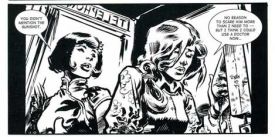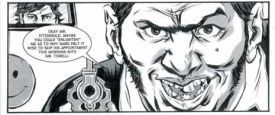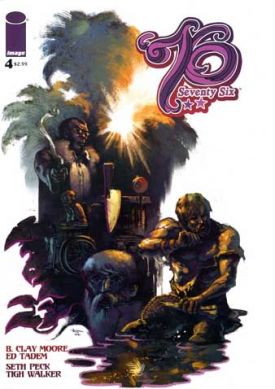Comics /
Comic Reviews /
More Comics
Seventy Six is Funkilicious
By Henry Chamberlain
August 5, 2008 - 11:40
Shaggy, druggy, and with a disco beat,
Seventy Six is what happens when a comic mixes the street cred of
Shaft with the swagger of
Starsky and Hutch. Issue 4 finds us at the midpoint of this limited series by
Image Comics.
In 1976, the year this comic takes place, America was reeling in the aftermath of Vietnam and Watergate. There was a sense that the country was adrift. Everyone seemed disillusioned whether in the mainstream or the counter culture. For example, this is the climate that gave us the original
Saturday Night Live with its nihilist edge and
All in the Family with its biting social commentary. It is this hopeless and cynical time that the creators of
Seventy Six play off on. Each issue is a double feature by two separate artist/writer partners who live up to this inspired premise: two pulp stories back to back set in 1976. One is in gritty New York; and the other is in skanky LA.
Both stories are very different while sharing a lot of common ground, particularly the fact that both are buddy stories: two partners, one black and one white, out to set things straight.
 |
| B. Clay Moore and Ed Tadem's "Jackie Karma" |
The first story, "Jackie Karma," by Moore and Tadem, is set in New York and follows the return of Jackie and Marcus to the streets to settle some old scores and maybe even give the people some hope. Ten years have passed since the two have done any fighting but they're wiser now and surprisingly haven't lost their touch. The art work helps to set the tone with expressive brush work that takes full advantage of moody swaths of black for this noir fantasy.
 |
| Seth Peck and Tigh Walker's "Cool" |
The second story, "Cool," by Peck and Walker, has a lighter touch and is set in LA. This time, the team is made up of Pete and Leon, more the mercenary types than do-gooders, who get on the wrong side of the mob. Full of over-the-top action sequences, its violence is balanced with stylish humor. The art work fits a more laid-back West Coast vibe with lighter line work and a variety of grays. There seems to be more room here for goofy characters and girls oozing sexuality. No doubt it can be found in the New York story too but with greater restraint.
If you're totally new to the '70s, there are plenty of stats to be found in the supplemental pages: sports, politics, pop culture and lots of music. Each issue supplies you with an impressive track list to enhance each story's mojo. For example: "Kung Fu Fighting by Carl Douglas (#1 on the pop charts in 1974, #1 on the black charts in 1975)"
Seventy Six is a funkilicious trip. Far out, man.
Last Updated: January 17, 2025 - 08:20


